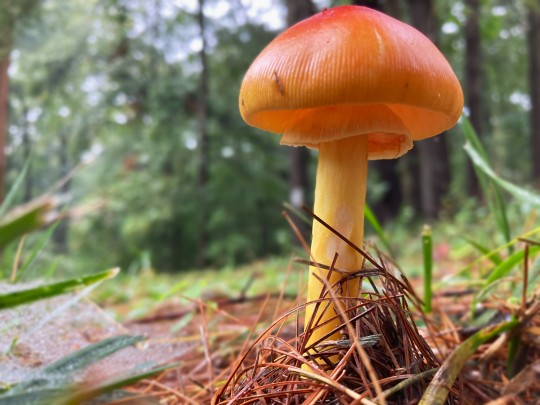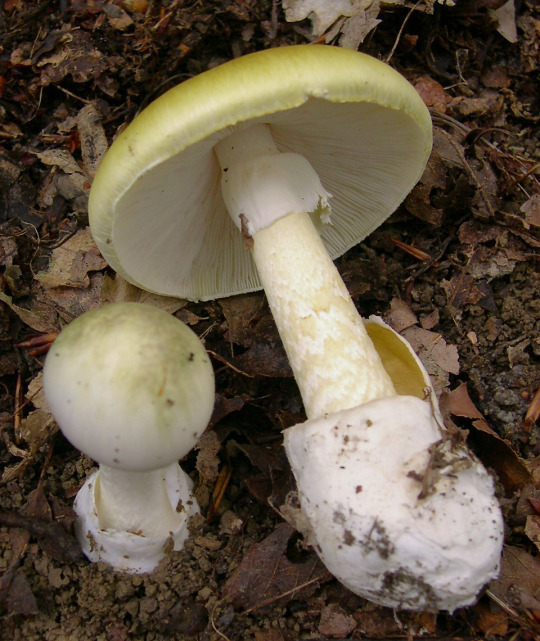#eastern caesar's amanita
Explore tagged Tumblr posts
Text



Jackson's slender amanita, just a matter of hours old
#they have not yet formed The Nipple. pics of older form to come#jackson's slender amanita#eastern caesar's amanita#amanita jacksonii#amanita#mushrooms#fungi#mycology#my photo
56 notes
·
View notes
Text
FOTD #129 : jackson's slender amanita!
jackson's slender amanita (also american slendercaesar, & eastern caesar's amanita) is :an agaric fungus in the family amanitaceae. it is found in canada, mexico & the US, forming mycorrhizal associations :-)
the big question : can i bite it?? this mushroom is edible, but not particularly recommended for consumption.


a. jacksonii description :
"the cap of the mushroom is 8–12 cm wide ; oval at first, becoming convex, typically with a central bump ; sticky ; brilliant red or orange, fading to yellow on the margin ; typically without warts or patches ; the margin lined for about 40–50% of the cap's radius. the red pigment fades from margin toward the centre with age. gills are moderately crowded to crowded, orange-yellow to yellow-orange to yellow. they are free from the stem or slightly attached to it ; yellow to orange-yellow ; crowded ; not bruising. the short gills are subtruncate to truncate. its stipe or stem (90–140 × 9–16 mm) is yellow & is decorated with orange fibrils & patches that are the remnants of a felted extension of the limbus internus of the otherwise white volva."
[images : source & source] [fungus description : source]
#• fungus of the day !! •#[amanita jacksonii]#: jackson's slender amanita :#: american slender caesar :#: eastern caeser's amanita :#129#||#mycology#fungus#mushrooms#mushroom#earth#nature#foraging#cottagecore#forestcore#fungi#fotd#fungus of the day#undescribed#image undescribed#amanita jacksonii#jackson's slender amanita#american slender caesar#eastern caeser's amanita
77 notes
·
View notes
Text

Amanita phalloides, the deadliest mushroom of the world
Commonly known as "death cap" internationally, this mushroom of European origin occurs now in all countries with temperate climate zones worldwide. It is particularly abundant in northern, central and eastern Europe, including Germany, where it forms an ectomycorrhiza symbiosis with broad leaf tree species.
Its similarity to edible mushroom species such as the straw mushroom and the white Caesar make it particularly dangerous. It may also be confused with the cultivated mushroom and the field or meadow mushroom, although clear distinguishing features exist.
Its deadly poison are heat-stable polycyclic oligopeptides of the amatoxin group with a lethal dose of about 0.1 mg per kg of body weight. This is equivalent to 20 to 40 grams of mushroom for an adult and 1 to 2 grams for children. The poison survives cooking, freezing and drying.
Amatoxins are highly efficient inhibitors of the RNA polymerase and disrupt gene expression in human cells. This causes nausea, vomiting and severe diarrhea about 8 to 12 hours after ingestion. At this time, the toxin has already distributed throughout the whole body and enriched in the liver, so any attempt to bind the toxin in the digestive tract is inefficient. The disruption of gene expression in the liver causes the liver cells to die and the liver to dissolve. Blood coagulation is severely disturbed, leading to severe interior bleeding. Hepathic encephalopathy leading to coma is the final cause of death and occurs six to ten days after ingestion.
Early stages or a mild poisoning is treated with Silymarin, an extract from the milk thistle, which inhibits the uptake of amatoxins into the liver cells. The ultimate cure for severe cases of amatoxin poisoning is a liver transplant. Due to these therapies, the death rate of cases of Amanita poisoning has been reduced from almost 100 % to 10 to 15 %. Early diagnosis and quick action are the prerequisites for a poisitive outcome.
Mushroom hunters in Europe usually know to distinguish the death cap from edible fungi, so cases among Europeans are rare. Immigrants, however, have more frequently suffered from Amanita poisonings. Many of the victims of the last decade came from Syria, where the death cap is unknown in many regions. In the USA, immigrants from south east Asia are frequent victims of Amanita poisoning. In Australia, signs warn mushroom hunters to abstain from their leisure activity in areas where Amanita phalloides has been introduced.
55 notes
·
View notes
Photo










Above are a few miscellaneous fungi photos from late summer and early fall hikes at various spots. Once again, I ask for forgiveness if I misidentify any of these lovely fungi - I’m still a noob to this strange but fascinating kingdom.
From top: pear-shaped puffball (Lycoperdon pyriforme); common earthball (Scleroderma citrinum); pinwheel marasmius (Marasmius rotula); salmon unicorn (Entoloma quadratum); short-stemmed russula (Russula brevipes); destroying angel (Amanita bisporigera) - the most deadly poisonous of the Amanitas; yellow patches (Amanita flavoconia) - which has a strong mycorrhizal (symbiotic) relationships with eastern hemlock and red spruce; eastern Caesar's mushroom (Amanita jacksonii); bleeding fairy helmet (Mycena haematopus); and chicken of the woods (Laetiporus sulphureus), also known as sulpher shelf fungus - one of the most popular edible mushrooms of North America.
#appalachia#vandalia#west virginia#fungi#mushroom#puffball#earthball#marasmius#entoloma#russula#amanita#mycena#laetiporus#shelf fungus#chicken of the woods
20 notes
·
View notes